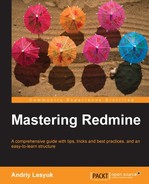Some readers may wonder why time tracking functionality is going to be reviewed in a separate chapter. If time tracking is provided by a small project module, then why have we not reviewed it along with other modules in the previous chapter? Other project modules, except issue tracking, do not provide enough functionality to make users install Redmine for them or have way better competitors (for example, MediaWiki or DocuWiki for the Wiki module; Invision Power Board or phpBB for the forums module, and so on). On the contrary, the time tracking module is complete, competitive (considering the functionality provided by Redmine core and its other project modules), and often enough becomes the main reason for using Redmine. Thus, I, personally, first used Redmine as a time tracking application.
So, in this chapter, we will speak about time tracking with Redmine. We will also mention its other functionality, especially the issue tracking, as Redmine time tracking is based generally on issues. This is the first (and only) chapter which you do not need to emphasize on (if you do not plan to use time tracking). If, however, you decide to continue reading it, you will learn how to submit your time entries to Redmine, how to generate time reports, and what third-party tools you can use to improve your Redmine time-tracking experience.
In this chapter, we will cover the following topics:
- Using Redmine time tracking
- Defining activity
- Tracking time
- Checking spent time
- Generating reports
Really, why Redmine should be chosen over other time tracking alternatives? The answer is because of the inclusion of other features that are not limited to issue tracking. Time-tracking applications rarely come alone, as the time tracking is a simple task and is unlikely to have many features. Thus, time tracking is also available in Trac, OrangeHRM, and so on.
Anyway let's see its benefits:
- In Redmine, time entries are associated with tasks, which are implemented using issues. This way, tasks can have detailed description of what should be done, can be shown on the Gantt chart, and much more.
- Due to the way issues are implemented, tasks can also have an estimated time which can be used to evaluate the speed of development, determine problematic tasks, and so on.
- Users can specify exactly what they were doing on the task, using the Comment field.
- Using the Activity field, administrators and project managers can categorize the time spent.
- Redmine allows adding time entries from SCM commit messages (described in details later).
- Spent time report is available (actually this is the only report available in Redmine).
- It can be a benefit or not, but Redmine supports only the hours value (which can be a float) and does not care about the start and the end times.
To enable the time tracking module for the project, make sure that the Time tracking checkbox is checked in project settings under the Modules tab.
To enable the time tracking module for new projects by default, go to Administration | Settings | Projects.
